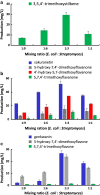High-yield production of multiple O-methylated phenylpropanoids by the engineered Escherichia coli-Streptomyces cocultivation system
- PMID: 30971246
- PMCID: PMC6456975
- DOI: 10.1186/s12934-019-1118-9
High-yield production of multiple O-methylated phenylpropanoids by the engineered Escherichia coli-Streptomyces cocultivation system
Abstract
Background: O-Methylated phenylpropanoids, which are generally present in small amounts in plants, have improved or distinct biological activities and pharmacological properties as opposed to their unmethylated counterparts. Although microbial production could be a useful tool for the efficient and environment-friendly production of methylated phenylpropanoids, a high-yield microbial production of neither tri-methylated stilbenes nor di-/tri-methylated flavonoids has been achieved to date.
Results: A methyltransferase from Streptomyces avermitilis (SaOMT2), which has been known to possess 7-O-methylation activity toward several flavonoids, exhibited more diverse regiospecificity and catalyzed mono-, di-, and tri-methylation of stilbene, flavanone, and flavone when it was expressed in Streptomyces venezuelae. For the efficient production of multi-methylated phenylpropanoids, a cocultivation system was developed by employing engineered Escherichia coli strains producing pterostilbene, naringenin, and apigenin, respectively, along with SaOMT2-expressing S. venezuelae mutant. Consequently, high-yield microbial production of tri-methylated stilbenes and di-/tri-methylated flavonoids (including 3,5,4'-trimethoxystilbene, 5-hydroxy-7,4'-dimethoxyflavanone, 4'-hydroxy-5,7-dimethoxyflavanone, 5,7,4'-trimethoxyflavanone, 5-hydroxy-7,4'-dimethoxyflavone, and 5,7,4'-trimethoxyflavone) has been demonstrated for the first time.
Conclusions: This cocultivation system based on the phenylpropanoid-producing E. coli and SaOMT2-expressing S. venezuelae provides an efficient tool for producing scarce and potentially valuable multi-methylated phenylpropanoids and will enable further development of these compounds as pharmaceuticals and nutraceuticals.
Keywords: E. coli–Streptomyces cocultivation; O-methylated phenylpropanoids; O-methyltransferase.
Conflict of interest statement
Provisional patent applications covering this work have been filed.
Figures






Similar articles
-
Engineering of plant-specific phenylpropanoids biosynthesis in Streptomyces venezuelae.J Biotechnol. 2009 May 20;141(3-4):181-8. doi: 10.1016/j.jbiotec.2009.03.013. Epub 2009 Mar 31. J Biotechnol. 2009. PMID: 19433224
-
Production of pinostilbene compounds by the expression of resveratrol O-methyltransferase genes in Escherichia coli.Enzyme Microb Technol. 2014 Jan 10;54:8-14. doi: 10.1016/j.enzmictec.2013.09.005. Epub 2013 Sep 21. Enzyme Microb Technol. 2014. PMID: 24267561
-
Microbial production of O-methylated flavanones from methylated phenylpropanoic acids in engineered Escherichia coli.J Ind Microbiol Biotechnol. 2019 Dec;46(12):1707-1713. doi: 10.1007/s10295-019-02239-6. Epub 2019 Oct 8. J Ind Microbiol Biotechnol. 2019. PMID: 31595455
-
Combinatorial biosynthesis of non-bacterial and unnatural flavonoids, stilbenoids and curcuminoids by microorganisms.J Antibiot (Tokyo). 2008 Dec;61(12):709-28. doi: 10.1038/ja.2008.85. J Antibiot (Tokyo). 2008. PMID: 19194030 Review.
-
Biosynthesis and production of glycosylated flavonoids in Escherichia coli: current state and perspectives.Appl Microbiol Biotechnol. 2015 Apr;99(7):2979-88. doi: 10.1007/s00253-015-6504-6. Epub 2015 Mar 10. Appl Microbiol Biotechnol. 2015. PMID: 25750049 Review.
Cited by
-
Towards Sustainable Agarwood Production: Integrating Microbial Interactions, Anatomical Changes, and Metabolite Biosynthesis.J Ind Microbiol Biotechnol. 2025 Aug 20;52:kuaf025. doi: 10.1093/jimb/kuaf025. Online ahead of print. J Ind Microbiol Biotechnol. 2025. PMID: 40833630 Free PMC article.
-
Naturally Occurring Flavonoids and Isoflavonoids and Their Microbial Transformation: A Review.Molecules. 2020 Nov 3;25(21):5112. doi: 10.3390/molecules25215112. Molecules. 2020. PMID: 33153224 Free PMC article. Review.
-
Identification of a polyphenol O-methyltransferase with broad substrate flexibility in Streptomyces albidoflavus J1074.Microb Cell Fact. 2024 Oct 5;23(1):265. doi: 10.1186/s12934-024-02541-8. Microb Cell Fact. 2024. PMID: 39369216 Free PMC article.
-
Metabolic engineering and optimization of Escherichia coli co-culture for the de novo synthesis of genkwanin.J Ind Microbiol Biotechnol. 2023 Feb 17;50(1):kuad030. doi: 10.1093/jimb/kuad030. J Ind Microbiol Biotechnol. 2023. PMID: 37738435 Free PMC article.
-
Production of (2S)-sakuranetin from (2S)-naringenin in Escherichia coli by strengthening methylation process and cell resistance.Synth Syst Biotechnol. 2022 Aug 3;7(4):1117-1125. doi: 10.1016/j.synbio.2022.07.004. eCollection 2022 Dec. Synth Syst Biotechnol. 2022. PMID: 36017331 Free PMC article.
References
MeSH terms
Substances
Grants and funding
LinkOut - more resources
Full Text Sources
Molecular Biology Databases

